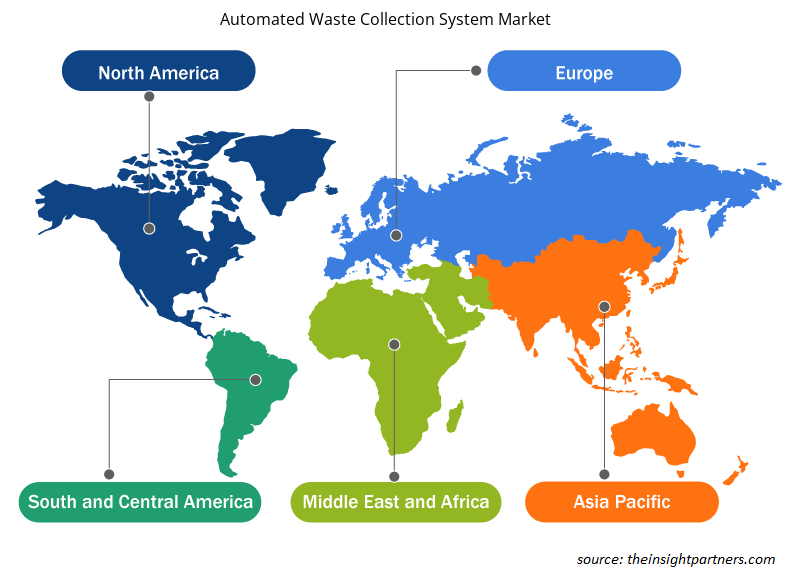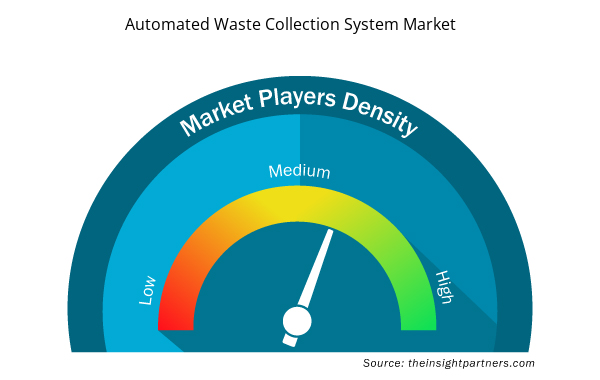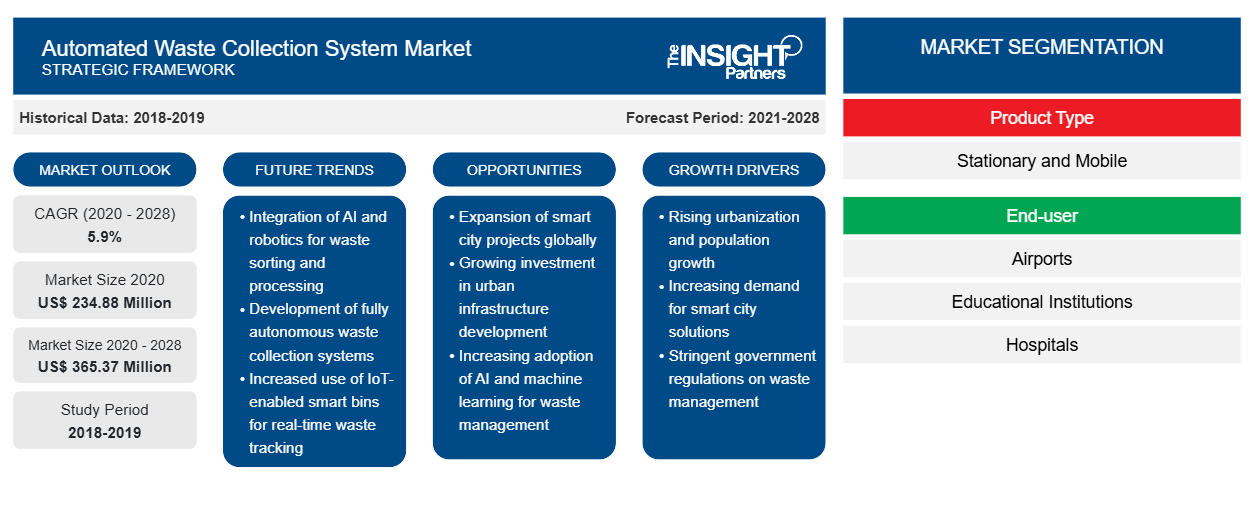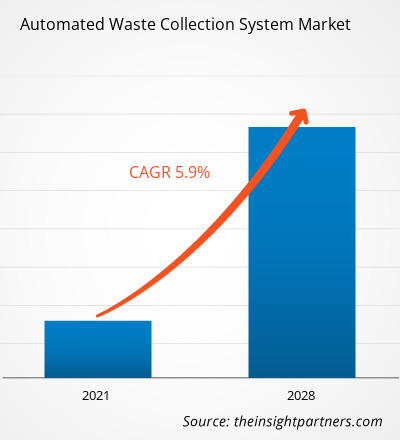Der Markt für automatisierte Abfallsammelsysteme wurde im Jahr 2020 auf 234,88 Millionen US-Dollar geschätzt und soll bis 2028 365,37 Millionen US-Dollar erreichen; für den Zeitraum 2021–2028 wird ein durchschnittliches jährliches Wachstum von 5,9 % erwartet.
Der Schlüsselfaktor, der den Markt für automatisierte Abfallsammelsysteme antreibt, sind die staatlichen Initiativen zur ordnungsgemäßen Abfallentsorgung. Regierungsbehörden auf der ganzen Welt haben Regeln und Vorschriften für die Sammlung und Trennung von Abfällen erlassen. So hat die indische Regierung beispielsweise neue Regeln für die Abfallbewirtschaftung erlassen, die die Trennung von Abfällen an der Quelle betonen. Die neuen Vorschriften verlangen, dass Abfälle an der Quelle getrennt werden, um sie durch Rückgewinnung, Wiederverwendung und Recycling in Kapital umzuwandeln. Daher müssen Abfallerzeuger sie vor der Übergabe an die Sammler in drei Ströme sortieren: biologisch abbaubare Abfälle, trockene Abfälle (Kunststoff, Papier, Metall, Holz usw.) und gefährliche Haushaltsabfälle (Windeln, Servietten, Mückenschutzmittel, Reinigungsmittel usw.). Die Trennung von Abfällen in großem Maßstab ist jedoch ein langwieriger Prozess, der die Regierungsbehörden dazu zwingt, sich auf automatische Lösungen zur Abfalltrennung zu konzentrieren. Diese Faktoren beeinflussen die Einführung automatisierter Abfallsammelsysteme in vielen Ländern weltweit.
Passen Sie diesen Bericht Ihren Anforderungen an
Sie erhalten kostenlos individuelle Anpassungen an jedem Bericht, einschließlich Teilen dieses Berichts oder einer Analyse auf Länderebene, eines Excel-Datenpakets sowie tolle Angebote und Rabatte für Start-ups und Universitäten.
- Holen Sie sich die wichtigsten Markttrends aus diesem Bericht.Dieses KOSTENLOSE Beispiel umfasst eine Datenanalyse von Markttrends bis hin zu Schätzungen und Prognosen.
Auswirkungen der COVID-19-Pandemie auf den Markt für automatisierte Abfallsammelsysteme
Die Hersteller automatisierter Abfallsammelsysteme auf der ganzen Welt erlebten jedoch begrenzte Erschütterungen, da die regionalen und lokalen Regierungen Kommunen und private Organisationen ermutigten, in intelligente Lösungen zur Abfall- oder Müllabfuhr und -sortierung zu investieren. Da die Haushaltsabfallmengen erheblich zunahmen, stieg die Nachfrage nach automatisierten Abfallsammelsystemen im privaten Sektor sprunghaft an. Aufgrund von Unterbrechungen der Lieferketten aufgrund der eingeschränkten Bewegungsfreiheit kam es jedoch zu einer langsameren Einführung und Installation der AWCS sowohl in Industrie- als auch in Entwicklungsländern wie den USA, Kanada, Großbritannien, Italien und China. Dies folgte einem langsameren als üblichen Umsatzwachstumstrend auf dem globalen Markt für automatisierte Abfallsammelsysteme
Markteinblicke – Markt für automatisierte Abfallsammelsysteme
Steigende Investitionen in die Integration automatischer Abfallsammelsysteme
Automatisierte Abfallsammelsysteme erfreuen sich in Gesundheitseinrichtungen großer Beliebtheit. Die Abfallmanagement- und -sammelsysteme transportieren Materialien mit 60 Meilen pro Stunde durch ein abgedichtetes, spezielles Rohrnetz von Ladestationen auf Patientenetagen zu einer zentralen Sammelstelle. Separate Wege werden verwendet, um Abfall, Kompost und schmutzige Wäsche zu den entsprechenden Sammelbehältern zu transportieren. Dies führt zu steigenden Investitionen in automatische Sammeltechnologien in Branchen wie Gastgewerbe, Gesundheitswesen und Einzelhandel. So hat Logiwaste AB beispielsweise drei verschiedene automatische Abfallsammelsysteme an das Karolinska-Krankenhaus in Stockholm geliefert. Diese Systeme sollen vier verschiedene Abfallarten bewältigen, nämlich Restmüll, Papier, Kunststoff und Papierverpackungen. Logiwaste AB hat auch Aufträge von Tiller Öst, Trondheim; Karlstad Central Hospital; Grilstad Marina, Trondheim; und China Life, Peking, zur Lieferung von AWCS erhalten. Ebenso hat Atreo Aufträge zur Lieferung von AWCS an das Parkland Hospital, das Humber River Hospital, das Brigham and Women's Hospital und das University of Texas Southwestern Medical Center erhalten, um nur einige zu nennen. Daher ist zu erwarten, dass die steigenden Investitionen von Unternehmen aus unterschiedlichen Branchen, insbesondere dem Gesundheitswesen, in die Implementierung automatischer Abfallsammlungs- und -managementsysteme das Marktwachstum in den kommenden Jahren ankurbeln werden.
Produkttypbasierte Einblicke
Basierend auf dem Produkttyp ist der Markt für automatisierte Abfallsammelsysteme in stationäre und mobile Systeme unterteilt. Das stationäre Segment hatte im Jahr 2020 einen größeren Marktanteil.
Erkenntnisse auf Grundlage der Inhaltsqualität
Basierend auf dem Endverbraucher ist der Markt für automatisierte Abfallsammelsysteme in Flughäfen, Bildungseinrichtungen, Krankenhäuser, Firmenbüros, Hotels/Restaurants und andere unterteilt. Das Flughafensegment wird im Prognosezeitraum voraussichtlich die höchste durchschnittliche jährliche Wachstumsrate verzeichnen.
Die Akteure auf dem Markt für automatisierte Abfallsammelsysteme konzentrieren sich hauptsächlich auf die Entwicklung fortschrittlicher und effizienter Produkte.
- Im Jahr 2021 realisierte Caverion ein schlüsselfertiges Projekt für einen Neubau des Biotechnologieunternehmens Thermo Fisher Scientific Baltics. Das Projekt fand in Vilnius, Litauen statt.
- Im Jahr 2021 entschied sich das Universitätskrankenhaus Stavanger für die automatische Abfall- und Wäscheabholung von Logiwaste AB. Das System bietet eine benutzerfreundliche, effiziente und hygienische Möglichkeit zur Handhabung von Abfall und Wäsche, von der Eingangstür bis zum Terminal.
Regionale Einblicke in den Markt für automatisierte Abfallsammelsysteme
Die regionalen Trends und Faktoren, die den Markt für automatisierte Abfallsammelsysteme während des gesamten Prognosezeitraums beeinflussen, wurden von den Analysten von Insight Partners ausführlich erläutert. In diesem Abschnitt werden auch Marktsegmente und Geografie für automatisierte Abfallsammelsysteme in Nordamerika, Europa, im asiatisch-pazifischen Raum, im Nahen Osten und Afrika sowie in Süd- und Mittelamerika erörtert.

- Erhalten Sie regionale Daten zum Markt für automatisierte Abfallsammelsysteme
Umfang des Marktberichts zum automatisierten Abfallsammelsystem
| Berichtsattribut | Details |
|---|---|
| Marktgröße im Jahr 2020 | 234,88 Millionen US-Dollar |
| Marktgröße bis 2028 | 365,37 Millionen US-Dollar |
| Globale CAGR (2020 - 2028) | 5,9 % |
| Historische Daten | 2018-2019 |
| Prognosezeitraum | 2021-2028 |
| Abgedeckte Segmente | Nach Produkttyp
|
| Abgedeckte Regionen und Länder | Nordamerika
|
| Marktführer und wichtige Unternehmensprofile |
|
Marktteilnehmerdichte: Der Einfluss auf die Geschäftsdynamik
Der Markt für automatisierte Abfallsammelsysteme wächst rasant, angetrieben durch die steigende Nachfrage der Endnutzer aufgrund von Faktoren wie sich entwickelnden Verbraucherpräferenzen, technologischen Fortschritten und einem größeren Bewusstsein für die Vorteile des Produkts. Mit steigender Nachfrage erweitern Unternehmen ihr Angebot, entwickeln Innovationen, um die Bedürfnisse der Verbraucher zu erfüllen, und nutzen neue Trends, was das Marktwachstum weiter ankurbelt.
Die Marktteilnehmerdichte bezieht sich auf die Verteilung der Firmen oder Unternehmen, die in einem bestimmten Markt oder einer bestimmten Branche tätig sind. Sie gibt an, wie viele Wettbewerber (Marktteilnehmer) in einem bestimmten Marktraum im Verhältnis zu seiner Größe oder seinem gesamten Marktwert präsent sind.
Die wichtigsten Unternehmen auf dem Markt für automatisierte Abfallsammelsysteme sind:
- Aerbin APS
- AMCS-Gruppe
- Caverion Corporation
- Envac AB
- Logiwaste AB
Haftungsausschluss : Die oben aufgeführten Unternehmen sind nicht in einer bestimmten Reihenfolge aufgeführt.

- Erhalten Sie einen Überblick über die wichtigsten Akteure auf dem Markt für automatisierte Abfallsammelsysteme
Der Markt für automatisierte Abfallsammelsysteme wurde wie folgt segmentiert:
Markt für automatisierte Abfallsammelsysteme – nach Produkttyp
- Stationär
- Mobile
Markt für automatisierte Abfallsammelsysteme – nach Endbenutzer
- Flughäfen
- Bildungseinrichtungen
- Krankenhäuser
- Firmenstandorte
- Hotels / Restaurants
- Sonstiges
Markt für automatisierte Abfallsammelsysteme – nach Geografie
Nordamerika
- UNS
- Kanada
- Mexiko
Europa
- Deutschland
- Frankreich
- Italien
- Vereinigtes Königreich
- Russland
- Restliches Europa
Asien-Pazifik (APAC)
- Australien
- China
- Indien
- Japan
- Südkorea
- Restlicher Asien-Pazifik-Raum
Naher Osten und Afrika (MEA)
- Saudi-Arabien
- Vereinigte Arabische Emirate
- Rest von MEA
Südamerika (SAM)
- Brasilien
- Rest von SAM
Firmenprofile
- Aerbin ApS
- AMCS-Gruppe
- Caverion Corporation
- Envac AB
- Logiwaste AB
- MariMatic Oy
- MEIKO
- Evakuierungsgruppe
- MABAT
- STREAM-Umgebung
- Historische Analyse (2 Jahre), Basisjahr, Prognose (7 Jahre) mit CAGR
- PEST- und SWOT-Analyse
- Marktgröße Wert/Volumen – Global, Regional, Land
- Branche und Wettbewerbsumfeld
- Excel-Datensatz



Report Coverage
Revenue forecast, Company Analysis, Industry landscape, Growth factors, and Trends

Segment Covered
This text is related
to segments covered.

Regional Scope
North America, Europe, Asia Pacific, Middle East & Africa, South & Central America

Country Scope
This text is related
to country scope.
Häufig gestellte Fragen
Automated waste collection systems are being highly preferred across healthcare institutions. The waste management and collection systems transfer materials at 60 miles per hour through a sealed, dedicated pipe network from loading stations on patient floors to a central collection operation. Separate paths are used to move waste, compost, and soiled linen to the appropriate collection bins. This is leading to the rise in investments in automatic collection technologies in industries such as hospitality, healthcare, and retail. For instance, Logiwaste AB has supplied three different automatic waste collection systems to Karolinska Hospital, Stockholm. These systems are projected to manage four different type of waste, namely, residual waste, paper, plastic, and paper packaging. Logiwaste AB has also won contracts from Tiller Öst, Trondheim; Karlstad Central Hospital; Grilstad Marina, Trondheim; and China Life, Beijing, to supply AWCS. Similarly, Atreo has received projects for supplying AWCS to Parkland Hospital, Humber River Hospital, Brigham and Women’s Hospital, and the University of Texas Southwestern Medical Center, among others. Thus, the rising investments by organizations from different industries, especially healthcare, to implement automatic waste collection and management systems is expected to fuel the growth of the market in the coming years.
Government bodies across the world have imposed rules and regulations for the collection and segregation of waste. For instance, the Government of India has specified new solid waste management rules emphasizing on the segregation of waste at source. The new regulations require waste to be separated at the source to channel it into capital through recovery, reuse, and recycling. Therefore, before handing over waste to the collectors, waste generators must sort it into three streams—biodegradables, dry (plastic, paper, metal, wood, etc.), and domestic hazardous waste (diapers, napkins, mosquito repellants, cleaning agents, etc.). However, the segregation of waste at a high scale is a tedious process, which is compelling government authorities to focus on automatic solutions of waste segregation. These factors are influencing the adoption of automated waste collection systems in many countries worldwide.
The stationary segment led the market in 2019 with highest share and is expected to continue its dominance during the forecast period. In stationary waste collection systems, the garbage is directly transported by pipes with the help of air pressure where it is compressed in seal containers. Thus, it is not required to be collected by trucks. Exhausters produce negative pressure in the pipe system, allowing air to flow freely. At ambient pressure, air enters the pipes, collecting the solid waste and carrying it to the collection station. The automated stationary waste collection systems can manage multiple waste forms simultaneously. In a standard collection method, two to four different waste streams are managed using the same transport pipes network.
Trends and growth analysis reports related to Manufacturing and Construction : READ MORE..
The List of Companies - Automated Waste Collection System Market
- Aerbin APS
- AMCS Group
- Caverion Corporation
- Envac AB
- Logiwaste AB
- Marimatic OY
- MEIKO
- EVAC GmbH
- MBAT
- Stream Environment
The Insight Partners performs research in 4 major stages: Data Collection & Secondary Research, Primary Research, Data Analysis and Data Triangulation & Final Review.
- Data Collection and Secondary Research:
As a market research and consulting firm operating from a decade, we have published and advised several client across the globe. First step for any study will start with an assessment of currently available data and insights from existing reports. Further, historical and current market information is collected from Investor Presentations, Annual Reports, SEC Filings, etc., and other information related to company’s performance and market positioning are gathered from Paid Databases (Factiva, Hoovers, and Reuters) and various other publications available in public domain.
Several associations trade associates, technical forums, institutes, societies and organization are accessed to gain technical as well as market related insights through their publications such as research papers, blogs and press releases related to the studies are referred to get cues about the market. Further, white papers, journals, magazines, and other news articles published in last 3 years are scrutinized and analyzed to understand the current market trends.
- Primary Research:
The primarily interview analysis comprise of data obtained from industry participants interview and answers to survey questions gathered by in-house primary team.
For primary research, interviews are conducted with industry experts/CEOs/Marketing Managers/VPs/Subject Matter Experts from both demand and supply side to get a 360-degree view of the market. The primary team conducts several interviews based on the complexity of the markets to understand the various market trends and dynamics which makes research more credible and precise.
A typical research interview fulfils the following functions:
- Provides first-hand information on the market size, market trends, growth trends, competitive landscape, and outlook
- Validates and strengthens in-house secondary research findings
- Develops the analysis team’s expertise and market understanding
Primary research involves email interactions and telephone interviews for each market, category, segment, and sub-segment across geographies. The participants who typically take part in such a process include, but are not limited to:
- Industry participants: VPs, business development managers, market intelligence managers and national sales managers
- Outside experts: Valuation experts, research analysts and key opinion leaders specializing in the electronics and semiconductor industry.
Below is the breakup of our primary respondents by company, designation, and region:

Once we receive the confirmation from primary research sources or primary respondents, we finalize the base year market estimation and forecast the data as per the macroeconomic and microeconomic factors assessed during data collection.
- Data Analysis:
Once data is validated through both secondary as well as primary respondents, we finalize the market estimations by hypothesis formulation and factor analysis at regional and country level.
- Macro-Economic Factor Analysis:
We analyse macroeconomic indicators such the gross domestic product (GDP), increase in the demand for goods and services across industries, technological advancement, regional economic growth, governmental policies, the influence of COVID-19, PEST analysis, and other aspects. This analysis aids in setting benchmarks for various nations/regions and approximating market splits. Additionally, the general trend of the aforementioned components aid in determining the market's development possibilities.
- Country Level Data:
Various factors that are especially aligned to the country are taken into account to determine the market size for a certain area and country, including the presence of vendors, such as headquarters and offices, the country's GDP, demand patterns, and industry growth. To comprehend the market dynamics for the nation, a number of growth variables, inhibitors, application areas, and current market trends are researched. The aforementioned elements aid in determining the country's overall market's growth potential.
- Company Profile:
The “Table of Contents” is formulated by listing and analyzing more than 25 - 30 companies operating in the market ecosystem across geographies. However, we profile only 10 companies as a standard practice in our syndicate reports. These 10 companies comprise leading, emerging, and regional players. Nonetheless, our analysis is not restricted to the 10 listed companies, we also analyze other companies present in the market to develop a holistic view and understand the prevailing trends. The “Company Profiles” section in the report covers key facts, business description, products & services, financial information, SWOT analysis, and key developments. The financial information presented is extracted from the annual reports and official documents of the publicly listed companies. Upon collecting the information for the sections of respective companies, we verify them via various primary sources and then compile the data in respective company profiles. The company level information helps us in deriving the base number as well as in forecasting the market size.
- Developing Base Number:
Aggregation of sales statistics (2020-2022) and macro-economic factor, and other secondary and primary research insights are utilized to arrive at base number and related market shares for 2022. The data gaps are identified in this step and relevant market data is analyzed, collected from paid primary interviews or databases. On finalizing the base year market size, forecasts are developed on the basis of macro-economic, industry and market growth factors and company level analysis.
- Data Triangulation and Final Review:
The market findings and base year market size calculations are validated from supply as well as demand side. Demand side validations are based on macro-economic factor analysis and benchmarks for respective regions and countries. In case of supply side validations, revenues of major companies are estimated (in case not available) based on industry benchmark, approximate number of employees, product portfolio, and primary interviews revenues are gathered. Further revenue from target product/service segment is assessed to avoid overshooting of market statistics. In case of heavy deviations between supply and demand side values, all thes steps are repeated to achieve synchronization.
We follow an iterative model, wherein we share our research findings with Subject Matter Experts (SME’s) and Key Opinion Leaders (KOLs) until consensus view of the market is not formulated – this model negates any drastic deviation in the opinions of experts. Only validated and universally acceptable research findings are quoted in our reports.
We have important check points that we use to validate our research findings – which we call – data triangulation, where we validate the information, we generate from secondary sources with primary interviews and then we re-validate with our internal data bases and Subject matter experts. This comprehensive model enables us to deliver high quality, reliable data in shortest possible time.


 Holen Sie sich ein kostenloses Muster für diesen Bericht
Holen Sie sich ein kostenloses Muster für diesen Bericht